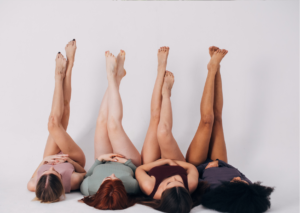The most important facts in a nutshell
reading time: about 4 minutes
- Menstrual products are often disposable and create vast amounts of waste that can take up to 500 years to decompose.
- In the course of your life, you will use more than 14,000 products for your period.
- There are now many sustainable alternatives that can replace tampons and panty liners.
- Menstrual cups, sponges or period underwear – the variety of sustainable products is growing.
Have you ever wondered how much waste is created by your period? Using tampons every four weeks – which have to be changed several times a day… Over time, this quickly adds up to a large amount. But that doesn’t have to be the case! There are now many sustainable alternatives to tampons and panty liners.
About 50 billion (!) menstrual products are consumed and thrown away every year – and these are only the figures for the EU. The fact that most conventional products contain plastic does not make the situation any better. On the contrary, it can take up to 500 years for used menstrual products to completely dissolve. Luckily, these days there are products that are not only better for the environment, but also for us! Free from plastic and ingredients. Today we present five sustainable alternatives to the well-known period products.
This is how much waste is created during your period
The annual amount of waste generated by menstruation in the EU is immense. But if we are honest, it is hard to imagine this number. We’ll show you how much waste you use and throw away during your period:
- Per day: Five pads and/or tampons (if both products are used in parallel and changed approximately every six hours).
- Per month: Menstrual products are usually used five to seven days per month (let’s agree on the middle and take six days in our example).
- In a year: Menstruating people have their periods on average 12 times a year.
- In life: Over the course of your life, you menstruate for about 40 years.

5 sustainable alternatives to tampons and panty liners
The following products not only protect the environment in the long term, but also your wallet. Unlike the well-known disposable products, you can use these sustainable menstrual products several times and even for years. Doesn’t sound bad, does it? We’d call it a classic win-win situation!
Period underwear
This sustainable alternative is pants that have an integrated soaker pad. It consists of several layers and ensures that the blood is absorbed and remains inside the padded liner. So nothing gets out – you feel dry and well protected. What’s more, after use you can simply wash it out with cold water and then put it in the washing machine. This way you can reuse them regularly.
Menstruation sponge
You probably haven’t heard much about this option yet, but menstrual sponges are a sustainable alternative to classic tampons. They are a natural product – so no nasty and harmful additives – and are inserted into the vagina during your period. Once they’re fully absorbed, you can take them out, clean them and use them again. Good to know: Although it may seem like it, menstrual sponges are not vegan! They are invertebrate multicellular organisms, but still a sustainable alternative.
Reusable panty liners
Unlike pads or traditional panty liners, reusable panty liners can be washed after use and then reused. They are usually made of organic cotton and can be worn like traditional pads. Our tip: Make sure you wash them at 60 degrees. This is the only way to remove bacteria and residues without any problems.
Menstruation cup
The menstrual cup is inserted into the vagina during the period, similar to a tampon or menstrual sponge, and catches the blood there. There are different models and sizes to choose from. Depending on how heavy your period is or whether you have already had a baby, you will need a different size than if you only have light bleeding. But all cups have one thing in common: they are made of medical silicone and can be used for up to 10 years if cared for properly.

Organic tampons
Organic tamponsAre you not yet convinced by our sustainable alternatives to traditional menstrual products or have you become accustomed to tampons? No problem! Of course, there are also organic tampons that have sustainable ingredients and packaging. Free of any chemicals and microplastics. Using them is the same as using normal tampons.
As you can see, there are many sustainable alternatives that protect you during your period and the environment. Just test which menstrual product is best for you and which you feel most comfortable with.



